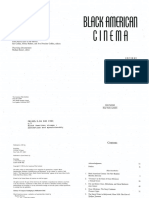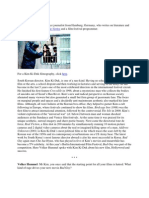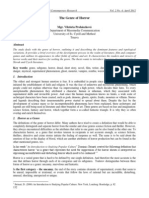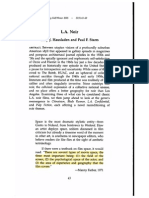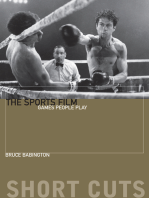Genre & Film Noir Double Indemnity
Genre & Film Noir Double Indemnity
Uploaded by
Mario Hernandez ChirinoCopyright:
Available Formats
Genre & Film Noir Double Indemnity
Genre & Film Noir Double Indemnity
Uploaded by
Mario Hernandez ChirinoCopyright
Available Formats
Share this document
Did you find this document useful?
Is this content inappropriate?
Copyright:
Available Formats
Genre & Film Noir Double Indemnity
Genre & Film Noir Double Indemnity
Uploaded by
Mario Hernandez ChirinoCopyright:
Available Formats
study guide 11
Genre and Film Noir Double Indemnity
CONTENTS
Hollywood, Film Noir, and the 1940s 02+03+04 Film Noir and Double Indemnity 05+06 German Expressionist Influences in Film Noir 07 Film Noir and New Production Techniques in Hollywood 08+09 Double Indemnity and the Crafting of Effective Scenes 10+11 Activity Answer Key 12+13+14
CURRICULUM
This teaching guide has three curriculum objectives: To help students and teachers using films and videos in the context of the following secondary school curriculum English Language Arts, Film and Media Studies, Social Studies, and Visual Arts To assist educators who are planning to teach film studies for the first time To suggest ways in which traditional literary concepts may be taught using a medium other than printed text
DOUBLE INDEMNITY Billy Wilder, 1944
Based on the novel by James M. Cain, Double Indemnity recounts the tale of Walter Neff (Fred MacMurray), an insurance salesman who becomes involved with the beautiful wife of a client. Together Neff and Phyllis Dietrichson (Barbara Stanwyck) concoct an insurance scam that will get rid of Mr. Dietrichson and allow the two lovers to run off with the proceeds from an insurance policy. Unfortunately, things dont work out, and in one of the films final sequences Walter and Phyllis are left in a standoff with each other, waiting to see who will blink first. Questions to think about prior to viewing the film: 1. Perhaps the most famous character in film noir movies is the femme fatale. Although you may not have a clear definition of a femme fatale in mind, in a few sentences, write down what you know about this kind of character. 2. In film noir, many of the male leads are weak, frustrated men. While you are watching Double Indemnity, make a mental note of Walter Neff s characteristics? What kind of man is he? What is his relationship like with women? 3. Film noir literally means black film. As you are watching the film, keep track of all the elements in the picture that seem dark or depressing. Think about the characters, the setting, and the storyline. After watching Double Indemnity, discuss the following questions: 1. Double Indemnity has been called a film without a single trace of pity or love. Do you agree with this statement? Think about the motivations that lie behind the actions of Walter Neff and Phyllis Dietrichson when you consider your response. 2. In your mind, are there any heroes in Double Indemnity? If so, who? 3. Film noir movies are still made in Hollywood today. Can you think of any recent detective films or movies about crime that have a similar look or mood? How do these films compare with Double Indemnity (a movie often thought of as the original film noir)?
Note: Classroom activities are provided after each section along with an answer key at the end of the guide. Answers are not provided for all activities as some questions depend on teachers to choose films they are already working with in their classes.
THE HISTORY OF FILM - STUDY GUIDE 11
Genre and Film Noir Double Indemnity |
01
HOLLYWOOD, FILM NOIR, AND THE 1940 S
The 1940s were a crossroads for Hollywood. Immediately following World War II, the picture looked bright for the American film industry. During the war, Hollywood studios, filmmakers, and stars had worked alongside the American government to promote the Allied war effort, and so with victory achieved, Hollywood emerged as a stable industry with, in fact, the only major national cinema left unscathed by the war. With newly opened markets throughout Europe and Southeast Asia as well as remarkable box-office returns at home all contributing to Hollywoods strength, American cinema seemed poised for a decade of growth. Just as this rosy picture was beginning to settle in, however, a series of blows befell Hollywood that would forever alter the American cinema.
The Paramount Decrees To begin with, while Hollywoods domestic audience reached more than 100 million in 1946 (twothirds of the population in the United States) just two years later, the Hollywood studio system that stood behind these numbers came crashing down. In May of 1948, the American government issued the Paramount Decrees, which charged that the five major studios (MetroGoldwyn-Mayer, Paramount, Warner Brothers, Twentieth Century Fox, and RKO) and the three minor studios (Universal, Columbia, and United Artists) had colluded in creating a monopoly over the production, distribution, and exhibition of motion pictures throughout the 1930s and 1940s. That the studios created a monopoly was no surprise to Hollywood observers. That the American government challenged this monopoly was a shock that forced the studios to sell off their lucrative movie theatre chains. Once the theatre chains were gone, Hollywood lost the ability to book new movies into their own theatres for long stretches of time, and as a result, the seemingly automatic box-office returns studios had grown used to were no more.
Inflation Beyond the Paramount Decrees, Hollywood was also hard hit by postwar inflation, which dramatically increased the costs of film production. On top of this, while Hollywood was initially given free access to national markets in Western and Eastern Europe, this ended in the late 1940s. Italy, Great Britain, and France (among other countries) levied protective taxes on all foreign film profits, severely limiting box-office receipts for American films. Once the Cold War between the Soviet Union and the United States moved into high gear in 1948, the Eastern European market was also lost. And so by 1950, Hollywoods financial structure seemed to teeter near ruin. But the real trouble was only just beginning.
Television Perhaps the most damaging development for the American film industry was the arrival of the television in the early 1950s. Television quickly changed the viewing habits of North American audiences. Between 1948 and 1950 Hollywoods box-office receipts dropped in direct proportion to the number of TV sets purchased, suggesting that Hollywood would burn as the vacuum tube phoenix took flight in the American home. Of course this didnt happen. By the late 1950s Hollywood recovered some of its stature in North America as the studios learned how to position films differently from TV. But between the years 1947 and 1958, Hollywood faced a period of adjustment that caused many to question whether Americas dream factory would survive at all.
Neorealism If events affecting the financial structure of Hollywood brought film to a crossroads in the 1940s, transformations in filmmaking emanating from beyond Americas shores were also changing Hollywood. With the end of World War II, the European film industries revived, led initially by a remarkable series of movies made in Italy. Between the mid-1940s and the early 1950s, a number of highly regarded and exceptionally influential films emerged from war-torn Italy as part of a movement called neorealism.
02 | Genre and Film Noir Double Indemnity
THE HISTORY OF FILM - STUDY GUIDE 11
The neorealists influenced filmmaking in countries around the world, including the United States, by using non-professionals as actors, shooting movies on location rather than in elaborate studios, and concentrating on social and political issues. Perhaps most importantly, the neorealists also developed a raw, semi-documentary approach to storytelling that helped to capture a world at the end of one great historical moment and the beginning of something wholly new. Some of the most important neorealist films include: Roberto Rossellinis Rome, Open City (1946), Pais (1946), and Germany Year Zero (1947); and Vittorio De Sicas The Bicycle Thief (1948) and Umberto D (1952). Certainly neorealists like Rossellini and De Sica evolved a raw, semi-documentary style as a result of the limited resources available to them in the years following World War II. Within this style, however, both filmmakers also found a revealing lens in which to capture the drama of post-war everyday life. The German occupation of much of Europe during World War II prevented many European filmmakers from portraying reality. Following the war, these same filmmakers turned with fascination and shock to the people, settings, and stories that dramatically unfolded before their eyes. This sense of realism would find its way into American noir movies of the late 1940s, including Robert Siodmaks The Killers (1946), Jules Dassins Brute Force (1947), and Henry Hathaways Kiss of Death (1947).
Citizen Kane The last important development that brought film to a crossroads in the 1940s had less to do with political, financial, or technological changes in the motion picture industry and more to do with the impact of one movie on filmmaking itself. Orson Welles Citizen Kane (1941) was not well received by audiences during its day, but filmmakers and critics recognized the movie as a masterpiece, twenty years ahead of its time. The formal structure of the film as well as the technical innovations in sound and lighting that Welles and his fellow artists developed were to have a tremendous influence on cinema for decades to come.
Film Noir And so as World War II came to a close and the euphoria of the immediate post-war years gave way to difficult social and economic transitions in Hollywood and in America generally, perhaps its no surprise that this period gave rise to a new, darker kind of film. Labelled film noir by French film critics, these movies drew on the international influence of the Italian neorealists as well as the look and tone of Citizen Kane. As we will see, noir films were relatively cheap to make so they were also ideally suited to the changing economic landscape in Hollywood. Beyond all these influences and coincidences, however, film noir also seemed to speak to post-war audiences in America and abroad. Noir films told stories of frustrated, weak, often times broken men who were victimized by scheming women in a world that cared little for the moral and ethical simplicity of earlier Hollywood movies. In this way, the noir cinema fit into and helped articulate a cultural landscape that had become filled with anxiety, uncertainty, and change in the wake of globalized warfare.
THE HISTORY OF FILM - STUDY GUIDE 11
Genre and Film Noir Double Indemnity |
03
HOLLYWOOD, FILM NOIR, AND THE 1940S continued activity 01
Film noir developed as a result of a number of influences and circumstances. Using a series of concentric circles like those below, detail the major influences and circumstances that impacted on the development of film noir as a genre. As you detail the influences and circumstances that impacted on the development of film noir, list the most immediate influences closest to the centre, and then list the remaining influences in degrees of importance.
Somewhat Influential
Influential
Most Influential
activity 02
The dissemination of television into North American homes was one of the major developments that brought Hollywood films to a crossroads in the 1940s. TV forced film studios to change the kinds of movies they made and the way movies were targeted at audiences. Once Hollywood learned how to differentiate movies from TV in the late 1950s, the film industry recovered its place with North American audiences, at least for a short time. Today, television has unquestionably replaced Hollywood movies as the dominant medium of communication, particularly with younger audiences. But now television, too, is facing a challenge; the Internet and the World Wide Web are threatening the status of TV as the dominant media of communication, particularly with younger audiences. Typically, a new medium of communication (for instance, the Internet) will begin to replace an older medium of communication (for instance, the TV) by mimicking the characteristics of the older form of communication. If this is true, in what ways are the Internet and the World Wide Web like TV today? How, for instance, does the World Wide Web look similar to TV? In what ways is our use of the World Wide Web similar to how we use or watch TV? And finally, how are advertisements used similarly on TV and on the World Wide Web?
04 | Genre and Film Noir Double Indemnity
THE HISTORY OF FILM - STUDY GUIDE 11
You might also like
- Critical Essays on Twin Peaks: The ReturnFrom EverandCritical Essays on Twin Peaks: The ReturnAntonio SannaNo ratings yet
- Just A Cog Double Indemnity Sequence AnalysisDocument5 pagesJust A Cog Double Indemnity Sequence Analysisapi-316047158No ratings yet
- Reading Through The Text: The Black Woman As AudienceDocument10 pagesReading Through The Text: The Black Woman As AudiencetratrojanNo ratings yet
- Rear Window VS Citizen KaneDocument7 pagesRear Window VS Citizen KaneChiefcoNo ratings yet
- REVISION Winters BoneDocument16 pagesREVISION Winters Bonearchie chisnallNo ratings yet
- Analysis of Jonathan Nolan's Memento MoriDocument6 pagesAnalysis of Jonathan Nolan's Memento MoriGelena Scribd100% (1)
- Feminism in Japanese Movie The Realm of The SensesDocument10 pagesFeminism in Japanese Movie The Realm of The SensesKevin WongNo ratings yet
- Femme Fatale of Film NoirDocument3 pagesFemme Fatale of Film NoirEvaNo ratings yet
- Film ReviewsDocument8 pagesFilm ReviewsMargie LakeNo ratings yet
- Essay Pulp FictionDocument5 pagesEssay Pulp FictiontomstyNo ratings yet
- Pulp Fiction - Contextual Studies Presentation - Hamza KaleemDocument21 pagesPulp Fiction - Contextual Studies Presentation - Hamza Kaleemh4mz4ra2No ratings yet
- Jonathan Rosenbaum - David Lynch Twin PeaksDocument6 pagesJonathan Rosenbaum - David Lynch Twin PeaksalexrgnNo ratings yet
- American Documentary Film - IntroductionDocument12 pagesAmerican Documentary Film - IntroductionElenaNo ratings yet
- Chungking Express PDFDocument8 pagesChungking Express PDFআলটাফ হুছেইনNo ratings yet
- The Birth of A New AvantDocument4 pagesThe Birth of A New AvantBogdan PetrovanNo ratings yet
- Of Ants and Men - Them! and The Ambiguous Relations Between (Monstrous) Immigration and (Apocalyptic) EntomologyDocument8 pagesOf Ants and Men - Them! and The Ambiguous Relations Between (Monstrous) Immigration and (Apocalyptic) EntomologyJuan Sebastián Mora BaqueroNo ratings yet
- Stand by Me NotesDocument5 pagesStand by Me Notessmasma1No ratings yet
- Shadow of A Doubt, A Criticism by William RothmanDocument74 pagesShadow of A Doubt, A Criticism by William RothmanSayantan DuttaNo ratings yet
- Animation EssayDocument3 pagesAnimation Essayapi-264080240No ratings yet
- I Edited Dildo Heaven - The Mark Boswell InterviewDocument7 pagesI Edited Dildo Heaven - The Mark Boswell InterviewBarron ShererNo ratings yet
- Camera StyloDocument4 pagesCamera StyloFröken SverigeNo ratings yet
- Representations of Class and Gender in Classical Hollywood MelodramaDocument9 pagesRepresentations of Class and Gender in Classical Hollywood MelodramaMatt Migliorini100% (1)
- Film Studies Important NotesDocument63 pagesFilm Studies Important NotesAkashNo ratings yet
- Movies and CultureDocument6 pagesMovies and CultureHerman Felani Tandjung-Nina100% (1)
- Textual Analysis PDFDocument5 pagesTextual Analysis PDFAna OnlyTimeNo ratings yet
- Kim Ki DukDocument6 pagesKim Ki DukRajamohanNo ratings yet
- Queer-Haptic Aesthetics in The Films ofDocument31 pagesQueer-Haptic Aesthetics in The Films ofDavid Pinheiro VicenteNo ratings yet
- 05-Robert J. Flaherty "Nanook of The North" (Edited by Reboratti)Document4 pages05-Robert J. Flaherty "Nanook of The North" (Edited by Reboratti)hugosallisNo ratings yet
- Film Noir and The American DreamDocument35 pagesFilm Noir and The American DreamEdward AveryNo ratings yet
- Media - Dark Knight Opening Textual AnalysisDocument3 pagesMedia - Dark Knight Opening Textual AnalysisGeorge FeastNo ratings yet
- The Representation of Violence To WomenDocument10 pagesThe Representation of Violence To WomenPavel Gabriel Tapia RomeroNo ratings yet
- Talking Space in Vertigo PomeranceDocument9 pagesTalking Space in Vertigo PomerancefuckduckNo ratings yet
- Race Representation in FilmDocument6 pagesRace Representation in FilmJohnNo ratings yet
- Zombies in Revolt The Violent Revolution of American Cinematic MonstersDocument20 pagesZombies in Revolt The Violent Revolution of American Cinematic MonstersRaphael CassouNo ratings yet
- 9, A Movie That Mixes All These Film Genres, Takes Place in The City of Johannesburg, South AfricaDocument3 pages9, A Movie That Mixes All These Film Genres, Takes Place in The City of Johannesburg, South AfricaJess FongNo ratings yet
- Dreyer's "The Passion of Joan of Arc"Document7 pagesDreyer's "The Passion of Joan of Arc"Brayden BenhamNo ratings yet
- Abella (Dogville - A Parable On Perversion)Document8 pagesAbella (Dogville - A Parable On Perversion)Seung-hoon JeongNo ratings yet
- International Film ComparisonDocument10 pagesInternational Film ComparisonYoung Major100% (1)
- The Political Philosophy of Toy Story 3Document2 pagesThe Political Philosophy of Toy Story 3Atleta SovieticaNo ratings yet
- Comparing John Paul Sarte To The Film BoyhoodDocument14 pagesComparing John Paul Sarte To The Film BoyhoodAngela VictoriaNo ratings yet
- PROHASZKOVA, Viktoria. The Genre of HorrorDocument11 pagesPROHASZKOVA, Viktoria. The Genre of HorrorVinicius AzevedoNo ratings yet
- Gender Displacement in Contemporary Horror (Shannon Roulet) 20..Document13 pagesGender Displacement in Contemporary Horror (Shannon Roulet) 20..Motor BrethNo ratings yet
- Aesthetics of Blue VelvetDocument7 pagesAesthetics of Blue VelvetAther AhmadNo ratings yet
- The Western 2.0Document12 pagesThe Western 2.0samuelburns1415No ratings yet
- Notes On GodfatherDocument20 pagesNotes On GodfathercflamNo ratings yet
- Postmodern Media Manipulate Time and SpaceDocument3 pagesPostmodern Media Manipulate Time and SpacebeccawhitmoreNo ratings yet
- What A Trip Road MoviesDocument18 pagesWhat A Trip Road MoviesSofi VNo ratings yet
- Tense, Mood, and Voice in FilmDocument15 pagesTense, Mood, and Voice in FilmMarcel VieiraNo ratings yet
- THE CINEMA OF DAVID CRONENBERG (Prikaz Knjige)Document4 pagesTHE CINEMA OF DAVID CRONENBERG (Prikaz Knjige)BulbulNo ratings yet
- John Ellis: Free CinemaDocument4 pagesJohn Ellis: Free CinemakilimandzsaroNo ratings yet
- Envisioning Queer Female FandomDocument231 pagesEnvisioning Queer Female Fandom1997ljwwNo ratings yet
- Mulholland Drive and PostmodernismDocument3 pagesMulholland Drive and PostmodernismOdette BrownNo ratings yet
- And Daisy Dod BreathlessDocument8 pagesAnd Daisy Dod BreathlessEmiliano JeliciéNo ratings yet
- L.A. Noir Gary J. Hausladen and Paul F. StarrsDocument28 pagesL.A. Noir Gary J. Hausladen and Paul F. StarrsIzzy MannixNo ratings yet
- Pornomiseria: or How Not To Make A Documentary FilmDocument10 pagesPornomiseria: or How Not To Make A Documentary FilmIván TorresNo ratings yet
- Amazing Plausible, Supernatural, and Surreal Horror Films (2019): State of TerrorFrom EverandAmazing Plausible, Supernatural, and Surreal Horror Films (2019): State of TerrorNo ratings yet
- Genre & Film Noir Double IndemnityDocument4 pagesGenre & Film Noir Double IndemnityMario Hernandez ChirinoNo ratings yet
- Technocultural Change, Education and New Configurations of Subjectivity. Mario Hernández ChirinoDocument188 pagesTechnocultural Change, Education and New Configurations of Subjectivity. Mario Hernández ChirinoMario Hernandez ChirinoNo ratings yet
- Applying Theories of Film Genre, Gender, Race, and Class To Film NoirDocument5 pagesApplying Theories of Film Genre, Gender, Race, and Class To Film NoirMario Hernandez ChirinoNo ratings yet
- Analisis Memento MementoDocument28 pagesAnalisis Memento MementoMario Hernandez ChirinoNo ratings yet
- Detour BFIDocument14 pagesDetour BFIMario Hernandez Chirino100% (1)
- Applying Theories of Film Genre, Gender, Race, and Class To Film NoirDocument5 pagesApplying Theories of Film Genre, Gender, Race, and Class To Film NoirMario Hernandez ChirinoNo ratings yet
- Robert SiodmakDocument12 pagesRobert SiodmakMario Hernandez ChirinoNo ratings yet
- Technocultural Change, Education and New Configurations of Subjectivity SubrayadoDocument188 pagesTechnocultural Change, Education and New Configurations of Subjectivity SubrayadoMarioHenry68No ratings yet


